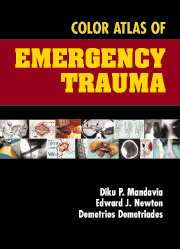1 - HEAD INJURY
Published online by Cambridge University Press: 10 November 2010
Summary
Introduction
Head injury accounts for the majority of deaths and severe disabilities due to trauma, and complicates the management of injury to other systems. Blunt head injury is most commonly the result of motor vehicle crashes, auto versus pedestrian collisions, or falls from significant heights. Gunshot wounds cause the vast majority of penetrating head injuries, although stab wounds and impalement injuries may also be seen.
Clinical Examination
Head injury is classified into mild, moderate, and severe categories, depending on the patient's Glasgow Coma Scale (GCS) (see Table 1.1) at the time of presentation. Mild head injury patients have a GCS of 14–15. Typically these injuries include concussion or transient loss of neurologic function, usually a transient loss of consciousness. Concussion does not result in any gross pathologic abnormalities of the brain, but subtle changes have been described using electron microscopy. Although the neurologic examination is usually normal in terms of quantifiable deficits, post-concussive neuropsychiatric symptoms are very common. These include amnesia for the event, headache, loss of concentration, dizziness, sleep disturbance, and a host of related symptoms. These symptoms resolve within two weeks for the vast majority of patients but may persist for many months in a small percentage. “Hard” neurologic findings such as diplopia, motor weakness, pupillary abnormalities, and other cranial nerve deficits are never due to post-concussive syndrome and demand further investigation.
Moderate head injury (GCS 8–14) and severe head injury (GCS <8) comprise a spectrum of injuries including cerebral contusion, diffuse cerebral edema, axonal shear injury, subarachnoid hemorrhage (SAH), and extra-axial lesions (subdural hematoma and epidural hematoma). The GCS is determined by the severity of the lesion and its time course.
- Type
- Chapter
- Information
- Color Atlas of Emergency Trauma , pp. 1 - 32Publisher: Cambridge University PressPrint publication year: 2003



